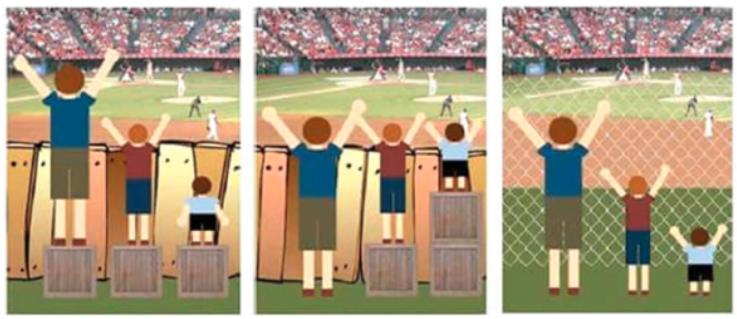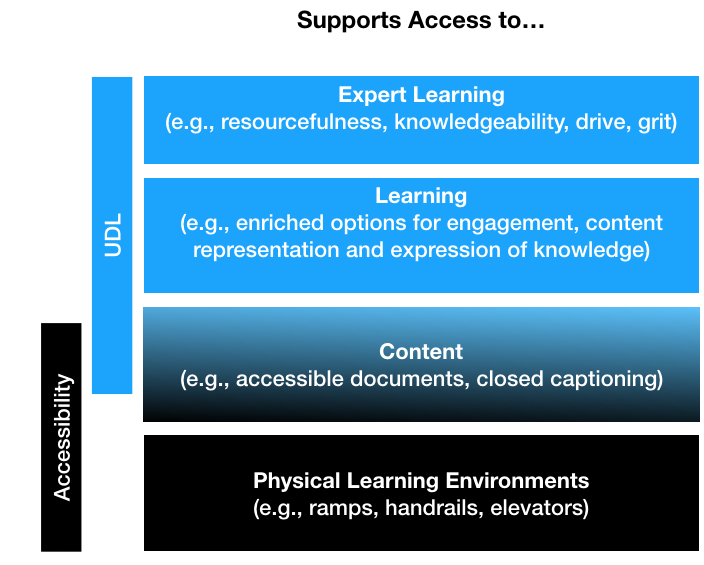Universal Design for Learning
Want to Learn About UDL?
Contact the Office of Innovative Technologies for more information about how our staff can support you in getting started or scaling up UDL as an individual, department, college, or other group. You can also find ideas and strategies via our asynchronous online course Implementing UDL on Canvas.
In addition to custom solutions, we offer:
- Enhancement evaluations (course or curriculum level)
- UDL consultation and design labs
- Training (by request and scheduled sessions)
- Action research
What is Universal Design for Learning?
Universal Design for Learning (UDL) is a framework for proactively creating accessible learning environments and experiences. Through the UDL lens, instructors design multiple and flexible strategies that are effective for our variable and diverse students. UDL puts emphasis on the role of the environment on enabling or disabling learners, rather than negatively labeling students themselves.

Left: equal, static instruction (“Traditional Instruction”). Center: Equitable support based on student need (“accommodations and modifications”). Right: Flexible learning experiences, such that variable learners have access (“UDL”).
How do instructors go about developing environments in which variable students may thrive without sacrificing rigor and challenge? That’s what UDL seeks to accomplish by expanding what we have traditionally considered with regards to accessibility.
UDL and Accessibility
Both the application of accessibility guidelines and the UDL design framework are intended to ensure equitable access for a variable range of students (e.g., ability/disability, interests/motivation, background knowledge/skill). Both call for proactive (design-oriented) strategies as opposed to reactive (e.g., accommodation-oriented) approaches. And ultimately, applying both will have the furthest-reaching benefit for your students, as depicted below .

UDL in Higher Education
Why UDL?
The best reason to invest time in UDL in higher education is because it works. Designing with UDL means improved effectiveness of instruction and -ultimately- efficiency for the learners and instructor alike. We know that at the University of Tennessee, some student groups are currently less likely to engage in a given class, learn in traditional ways, and ultimately graduate. UDL provides us with a framework to remove barriers for all of our students without sacrificing rigor.
Yes! A great deal of it!
UDL draws from strong foundational theory including the seminal works of Piaget, Vygotsky, and Bloom, who drew from similar principles for framing individual differences and the teaching strategies for addressing them. Additionally, this design process overlays with established best practices for design from the fields of instructional design and universal design (originally an architectural concept).
The UDL principles and guidelines are also supported by over 800 peer-reviewed research articles. They also provide benchmarks that guide educators in the development and implementation of UDL curriculum.
UDL doesn’t create new methods of teaching and learning, but rather organizes and frames established best practices according to recent developments in what we know about how people learn.
Get Started with UDL
UDL practitioners start small and scale up. What matters most is a willingness to jump in and get going.
Getting started with UDL can be accomplished with small steps. The authors of UDL on Campus compiled several tips for getting started from those practicing UDL in higher education (adapted here):
- Have students help drive the changes. Have them be partners in the learning. They can be a great help to understanding what they need to be more successful.
- Start with tight learning goals for your students and how you can provide flexibility in how students demonstrate mastery of those goals.
- Think about how materials can be influenced by the guidelines:
- Represent content in multiple ways
- Provide multiple ways that students can express themselves and demonstrate their understanding
- Enable your students with multiple ways to engage with the curriculum and manage their own learning
- Enlist the help of other faculty, talk with each other about your experiences implementing UDL.
- Listen to a podcast from Teaching in Higher Ed where Bonni Stachowiak, Ed.D speaks with Mark Hofer, Ph.D. about his experience in implementing UDL in his teaching (para. 3).
UDL Resources
- UDL on Campus (a CAST resource)
- UDL Theory and Practice (free account creation required)

 Explore
Explore Write
Write Chat
Chat Call
Call